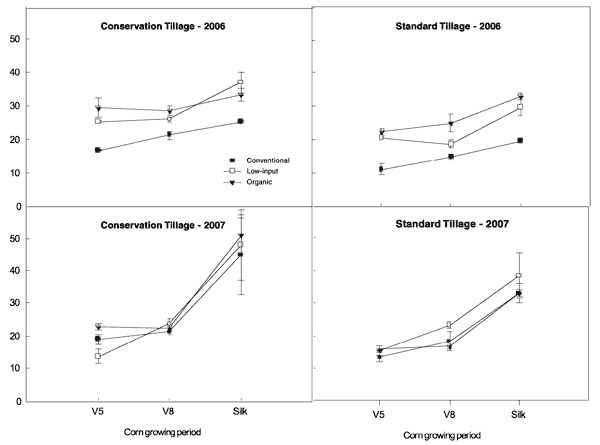| • Table of Contents • |
Fall 2008 - Vol. 9/No. 1
Cover crops and conservation tillage increase mycorrhizal colonization of corn and tomato roots
Arbuscular mycorrhizal fungi (AMF) are found in virtually all soils, where they colonize the roots of more than 80 percent of all plant species including those of most agricultural crops. AMF are obligate symbionts, which means they can only live in or on plant roots. The plant roots provide them with essential carbohydrates, and the fungi benefit the host plant by enabling it to more efficiently take up phosphorus (P) and other nutrients of low mobility normally “locked up” in the soil.
The question is how do AMF help the host plants? The answer is that AMF help plants absorb nutrients through the AMF’s external hyphae (mycelia), which proliferate in the surrounding soil. AMF hyphae also play an important role in soil conservation by improving soil aggregate stability. If growers properly manage soil, naturally occurring AMF could increase, which would reduce or eliminate the use of some synthetic fertilizers such as P. This is a distinct energy savings compared to the effort of mining, crushing and transporting P fertilizer to growers’ fields.
In 2006 and 2007, we studied how management practices such as cover cropping and tillage affect the status of beneficial AMF root colonization at the UC Davis Sustainable Agriculture Farming Systems (SAFS) plots.
Methods and Materials
At the SAFS plots, two-year rotations of processing tomatoes and corn are managed as conventional, low-input or organic farming systems in three replications. The conventional system received synthetic fertilizer, and in winter, plots remained fallow. In the low-input system, small amounts of synthetic fertilizer were applied, and in winter a mixture of three types of cover crops were grown. The organic system received composted chicken manure, and in winter a three cover crop mixture was planted. In each plot of these farming systems, two tillage treatments were imposed: standard tillage (ST) that included fall and spring plowing, and conservation tillage (CT) that included spring plowing only.
In corn, mycorrhizal colonization in roots was measured at the five-leaf (V5), eight-leaf (V8) and silking (Silk) stages of randomly collected plants. Similarly, in the tomato systems, plants were sampled at the early bloom (EB), early fruit (EF) and mid-fruit (MF) stage. Root samples were washed and preserved in 50% ethanol. The preserved roots were autoclaved and then stained with trypan blue. Total root length and mycorrhizal colonization were assessed with the line-intersect method.

Results and Discussion
Generally, mycorrhizal colonization was highest at the silking stage, intermediate at the V8 and lowest at the V5 stage (Figure 1). Similarly, tomato mycorrhizal colonization was higher at the mid-fruit stage than at the early fruit and early bloom stages (data not shown). Overall, mycorrhizal colonization in corn and tomato was significantly greater in organic and low-input systems than in conventional systems. In the conventional systems, plots remained fallow during the winter and this may have caused a reduction in mycorrhizal populations. When soil lies bare through winter, the AMF populations are deprived of the vital carbohydrates they normally get from their symbiotic relation with the plant roots, and they diminish substantially by the beginning of the next cropping season. If a cover crop such as oats, vetch, faba bean or some combination of these is grown as in the organic and low-input systems, AMF can be nourished during the winter by the roots, which keeps their populations high.
Mycorrhizal colonization was also significantly greater in conservation tillage plots than in fields maintained with standard tillage practices both in corn (Figure 1) and tomato (data not shown) in 2006 and 2007. Although tillage can serve as a method of post-emergence weed control and as a management tool to disrupt pest incidence, it also harms AMF populations by disrupting their hyphal networks, which negatively influences AMF-induced plant growth. Fall tillage is even more damaging than spring tillage to mycorrhizal fungi because hyphal networks are disrupted, and it is hard for hyphae detached from the root to survive over the winter.
Our results suggest that cover crops significantly boosted the mycorrhizal population, which may result in a greater uptake of P and other nutrients. Our data show that the timing of tillage is also important in the management of naturally occurring mycorrhizal fungi. In this study, it was suggested that fall tillage greatly reduced mycorrhizal population, with only small effects from spring tillage. Proper management of mycorrhizal fungi is essential in the improvement of sustainable agricultural production in both conventional and organic systems.